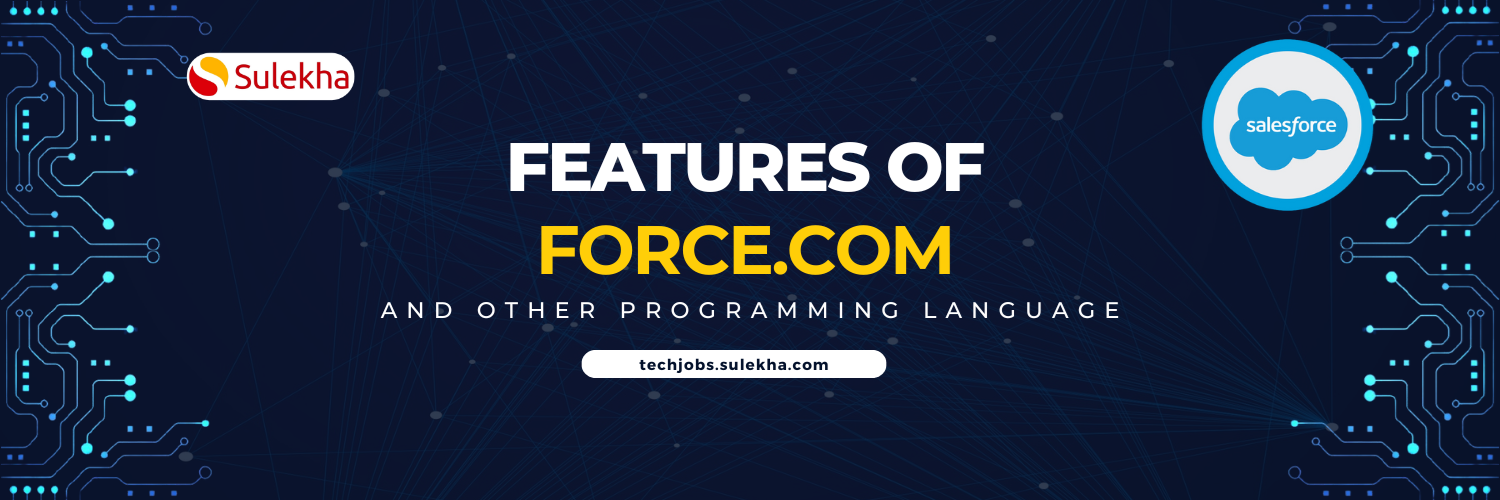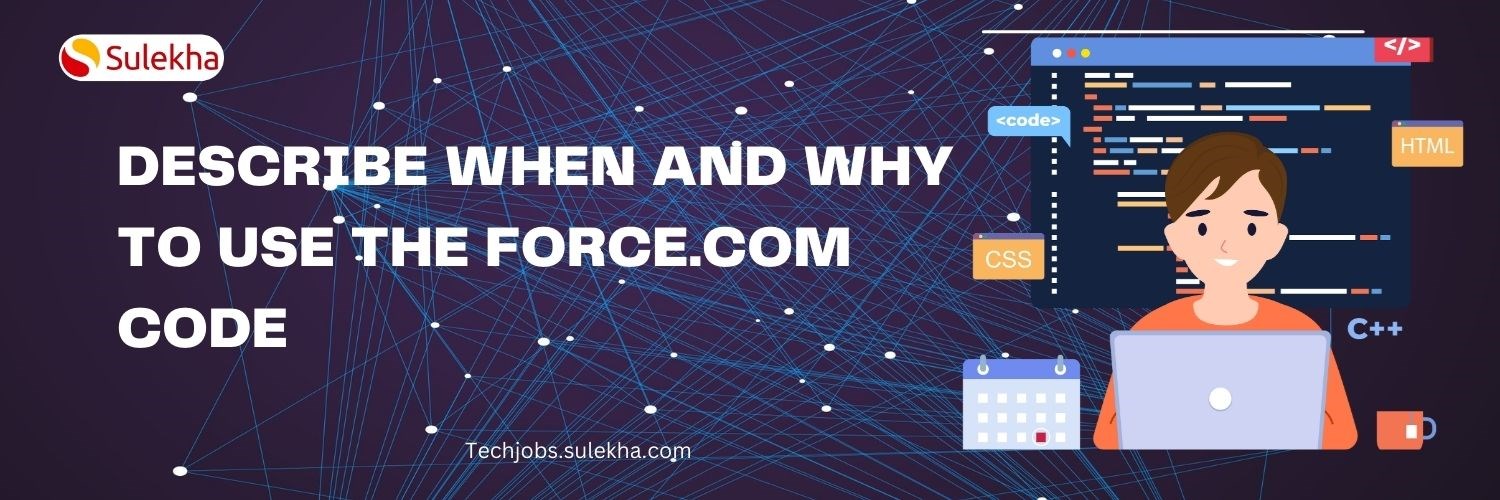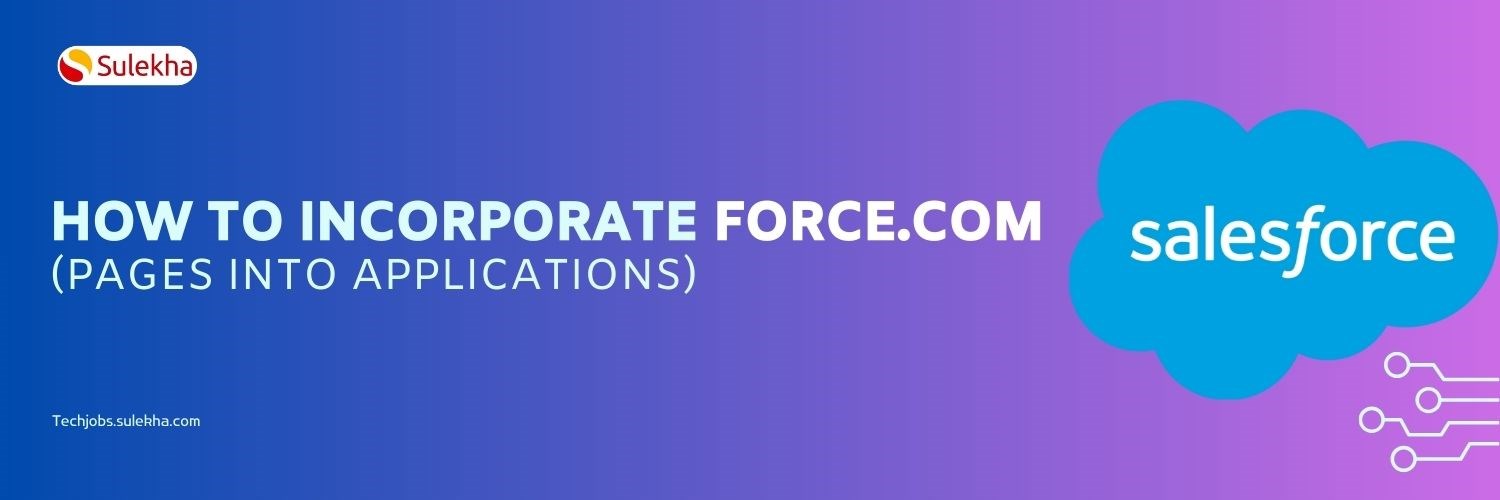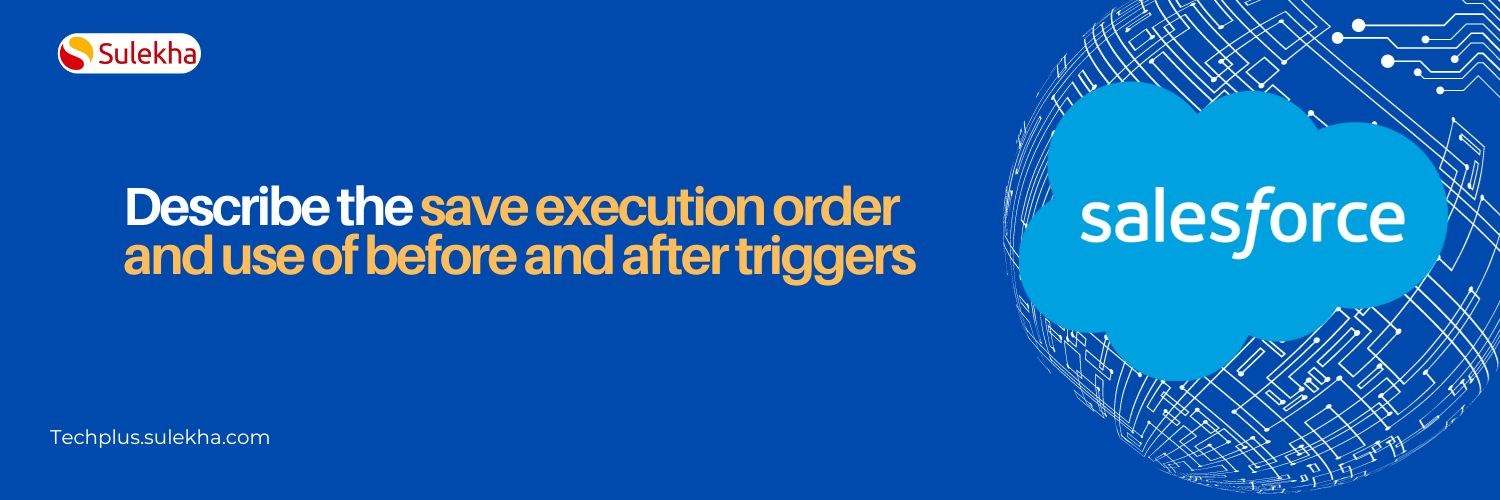Features of Force.com code and distinguish between Force.com code and other programming languages.

Welcome to the dynamic world of Force.com, where innovation meets accuracy in application development. Imagine a programming environment beyond the ordinary, designed exclusively to elevate your creations within the Salesforce ecosystem. Step into Apex, the heartbeat of the Force.com platform, where your code doesn't just run; it orchestrates seamless interactions with Salesforce data, responds to real-time events, and propels your applications to new heights.
In this realm, you're not just coding; you're sculpting solutions with the prowess of an object-oriented language built for the cloud. Apex isn't just a language; it's the conduit to unleash Salesforce's full potential, tightly integrating your creations with the platform's vast array of services.
Before discussing the features of Force.com code and its key differences from other programming languages, we shall discuss what Force.com is.
What is Force.com?
Force.com, Salesforce's brainchild, is a cutting-edge cloud platform that revolutionizes application development. Offering a unique blend of power and simplicity, it lets developers create robust enterprise applications without the hassle of infrastructure management.
When engaging in application development on the Force.com platform, there is no requirement for additional hardware or software or the allocation of resources towards configuration and maintenance, specifically regarding databases and hardware. The Force.com platform offers three predefined application categories, encompassing Salesforce.com CRM apps. The primary classifications are as follows:
Sales Cloud
Service Cloud
Chatter
At its core is Apex, an object-oriented language tailored for the cloud that seamlessly integrates with Salesforce services. Force.com stands out with its event-driven programming, employing triggers that respond to real-time data changes. It's a realm where declarative development coexists with code, setting the stage for a dynamic and efficient application-building experience.
In essence, Force.com is your ticket to a world where innovation meets ease, unlocking the full potential of cloud-based development. Here are key features of Force.com code (Apex) and distinctions from other programming languages. Before reading Salesforce's features further, we should understand the architecture of the Force.com platform.
The architecture of the Force.com platform
Force.com's optimized metadata-driven architecture delivers outstanding performance, scalability, and customization for on-demand, multitenant applications. Moreover, it provides additional advantageous features in the cloud computing model. We can pay only for the hardware and software we use because we can obtain Force.com as a platform as a service.
Key features of Force.com platform
The following are the key features of the Force.com platform:
Multitenancy
Application services
Force.com metadata
MVC architecture
Programming language
Integration
Force.com sites
AppExchange
Multitenancy
Multitenancy in Force.com refers to the architectural design where multiple organizations or tenants share the same software instance while keeping their data and configurations isolated. In the context of Force.com, different companies or users can utilize the Force.com platform simultaneously, each having its distinct data, configurations, and applications.
Advantages of multitenancy
Efficiency
Scalability
Cost-Effective
Resource Sharing
Centralized Maintenance
Application services
In the traditional project development method, we need to integrate or build additional applications for support, such as e-mail functions, login, UI (User Interface), validations, testing, and integration. Moreover, you are required to create supporting applications based on the projects.
The launch of the Force.com platform provided Multitenant application support for different projects—these integrated application support aid developers in developing business-based applications.
Example: Force.com platform has various integrated features for automating business processes such as e-mail functions, login, UI - User Interface, validations, testing, and integration. With the aid of the Salesforce platform services, developers can build an application quickly.
Force.com metadata
Force.com metadata refers to the configuration and customization information that defines the structure and behavior of applications built on the Force.com platform.
This metadata includes settings, objects, fields, page layouts, workflows, and other elements that determine how the application functions and appears to users. Unlike data, which represents the information stored in the application, metadata describes the instructions on how the application should operate and be structured. Force.com metadata is crucial for defining the architecture, business logic, and user interface of applications developed on the platform.
Advantages of the metadata-driven model
Flexibility
Configurability
Efficiency
Consistency
Collaboration
MVC architecture
MVC (Model-View-Controller) architecture separates an application into three interconnected components—Model (data and business logic), View (user interface), and Controller (handling user input)—to enhance modularity and maintainability.
Programming language
The Force.com platform provides programming languages, markup, query, and search languages.
Apex
It is the most demanding programming language of the Force.com platform. Apex is object-oriented, but its syntax is similar to C# and Java.
Developers can construct the logic of their applications by interacting with the platform's pre-existing capabilities. Apex is categorized as a controller component based on the Model-View-Controller (MVC) architecture. This is due to its utilization in developing controller classes and triggers on the Force.com platform. Apex possesses the capability to be utilized for:
Create custom controllers/Controller extensions
Develop triggers automatically executed within records, encompassing actions like insertion, modification, deletion, and restoration of particular objects.
Access and invoke external web services
Create batch jobs
Visualforce
Visualforce is a software framework that embodies the Model-View-Controller (MVC) architectural pattern. Within the Force.com platform, it is possible to create Force.com applications that incorporate customized and standard objects. Each object has a predefined user interface with one or more page layouts. However, utilizing conventional page formats for complex specifications is not feasible. Visualforce is a significant component in this context.
Visualforce is a web-centric framework for creating user interfaces that can construct intricate, visually appealing, and interactive custom user interfaces. Visualforce enables developers to leverage widely used web development tools, including jQuery, JavaScript, CSS, and HTML5. Hence, developing visually appealing user interfaces (UIs) for many applications, including those designed for mobile devices, is feasible.
Visualforce is a web-centric framework for building user interfaces that can create intricate, visually appealing, and interactive custom user interfaces. Visualforce enables developers to leverage widely used web development tools, including jQuery, JavaScript, CSS, and HTML5. Therefore, we can build rich UIs for any app, including mobile apps.
SOQL
The Salesforce Object Query Language (SOQL) enables data retrieval from Salesforce objects. Its syntax is simpler than that of SQL. As an illustration, it is worth noting that SOQL incorporates the SELECT keyword. However, it does not encompass the INSERT or UPDATE keywords. The key difference from SQL is that SOQL doesn't have the JOIN keyword. SOQL may be utilized in Apex programs and provides a powerful tool for manipulating and processing data.
Integration
Integration in the Force.com platform refers to the seamless connection and interaction between Salesforce applications and external systems, enabling data exchange and processes. Linking Salesforce with other applications, databases, or services allows real-time collaboration, improved workflow automation, and a unified experience.
Using an open Simple Object Access Protocol (SOAP) web service, the Force.com API provides access to all the data stored in the application.
There are integration benefits as follows
It takes less time to integrate Force.com technology than traditional integrations.
The Force.com platform-based API enables direct, low-level access to Salesforce application data and metadata.
There are numerous possibilities for selecting integration technologies and solutions that will work with their existing system.
Proven platform and integration
Force.com sites
Force.com sites enable us to build public websites with Salesforce.com data, Visualforce, and conventional web technologies like CSS, JavaScript, and jQuery. Because Force.com sites are directly integrated with Salesforce, user identification using the Salesforce login and password is not required.
A Force.com site has the following features and benefits
Data from selected organizations can be publicly available via your domain URL.
Force.com sites are hosted on Salesforce servers. Thus, there are no integration problems.
It can be built using Visualforce pages
You can turn the user registration on or off according to the requirement.
AppExchange
AppExchange on Force.com is Salesforce's marketplace for discovering, installing, and integrating third-party applications that extend and enhance the functionality of the Force.com platform. It offers a diverse range of certified apps and provides users with tools, components, and services to tailor their Salesforce experience.
Force.com (Apex) key features
Object-Oriented: Developers can represent things in the real world and encapsulate data and behavior within objects using the object-oriented programming language Apex.
Integration with Salesforce Platform: Apex exhibits a high level of integration with the Salesforce platform, enabling effortless and persistent access to Salesforce data and services. Developers can write triggers, classes, and methods to engage with and manipulate Salesforce records.
Governor Limits: Force.com sets governor restrictions to ensure adequate resource utilization. These constraints govern how much data and resources a transaction can utilize while ensuring the platform's stability.
SOQL and SOSL: Apex uses Salesforce Object Query Language (SOQL) to query data and Salesforce Object Search Language (SOSL) to search multiple objects. This simplifies data retrieval and manipulation.
Event-Driven Programming: The Apex programming language provides support for triggers and event-driven code, which can be executed either before or after records are inserted, edited, deleted, or undeleted. This functionality allows software developers to effectively react and adapt to modifications occurring within the Salesforce database.
Web Services Integration: The Apex platform offers functionality for seamless integration of external web services, enabling developers to utilize and interact with SOAP and RESTful web services efficiently.
Distinctions from Other Programming Languages
Force.com code, predominantly written in Apex, distinguishes itself from other programming languages through its specialized focus on cloud-based development within the Salesforce ecosystem. Unlike general-purpose languages, Apex is tightly integrated with Salesforce services, emphasizing seamless access to Salesforce data and efficient event-driven programming through triggers. Its proprietary nature limits its use outside the Salesforce platform, making it highly specialized. With features like governor limits for resource efficiency and a declarative development approach, Force.com code is uniquely tailored for building scalable, enterprise-level applications in a cloud-centric environment, setting it apart from more versatile but less platform-specific programming languages.
Now, we shall see some of the unique distinctiveness in detail.
Proprietary Nature: The Apex programming language is exclusive to Salesforce and explicitly designed for use on the Force.com platform. In contrast to more universally adaptable programming languages, this language has limited applicability, as it can only be utilized within Salesforce contexts.
Tightly Integrated with Database: Apex is tightly integrated with Salesforce's database structure, making it especially efficient for interacting with Salesforce data. However, this tight integration may limit its versatility in non-Salesforce contexts.
Declarative Development: A programming language, Apex, is further supported by Force.com, which supports declarative development with tools such as Process Builder and Flow. In software development, it is common for developers to employ a hybrid approach that combines both declarative and programmatic methodologies.
Governor Limits: The imposing governor limits are unique to the Force.com platform. While it ensures efficient resource usage, developers must be mindful of these limits when designing and executing code.
Designed for Cloud Environments: Apex is highly optimized for cloud-based, multitenant systems, harmonizing with Salesforce's architecture centered on cloud computing.
In conclusion, Force.com code, predominantly fueled by Apex, is a specialized and powerful tool for crafting applications within the Salesforce ecosystem. Its distinctiveness lies in its seamless integration with Salesforce services, efficient event-driven programming, and a focus on cloud-based development.
While other programming languages offer versatility across various platforms, Force.com code excels in its precision and optimization for Salesforce, making it the go-to choice for developers navigating the unique challenges and opportunities of cloud-centric, enterprise-level application development.
Find a course provider to learn Salesforce
Java training | J2EE training | J2EE Jboss training | Apache JMeter trainingTake the next step towards your professional goals in Salesforce
Don't hesitate to talk with our course advisor right now
Receive a call
Contact NowMake a call
+1-732-338-7323Take our FREE Skill Assessment Test to discover your strengths and earn a certificate upon completion.
Enroll for the next batch
Salesforce Course Online Training
- Dec 15 2025
- Online
Salesforce
- Dec 16 2025
- Online
Salesforce Course Online Training
- Dec 17 2025
- Online
Salesforce
- Dec 18 2025
- Online
Salesforce Course Online Training
- Dec 19 2025
- Online
Related blogs on Salesforce to learn more

INTRODUCTION TO CLINICAL RESEARCH
Learn the fundamentals of clinical trials, and eight phases of the clinical research process.

Describe when and why to use the Force.com code
Discover how to leverage the power of Apex code to automate business processes, enhance user experience, and improve data quality in your Salesforce organization.

List and Describe Syntax Features of Force.com Code
Master the syntax features of Force.com code and description for each feature.
An Introduction: Integrating with the Salesforce Force.com Platform
Unlock the full potential of your Salesforce implementation by integrating it with external systems and applications.

Describe How to Incorporate Force.com Pages into Force.com Applications
Learn how to seamlessly integrate Force.com pages into your Salesforce applications to enhance user experience and discover the steps to create, customize, and deploy custom pages that meet your specific business needs.

Describe the save execution order and use of before and after triggers
Learn how to write triggers that execute at the right time to meet your specific business needs

Debugging, Testing, and Monitoring in Force.com: A Comprehensive Guide
Explore the essential techniques for debugging, testing, and monitoring your Force.com applications.
A Comprehensive Guide to Managing Static Resources in Salesforce
We have discussed the types of Static Resources, how to Create & Use Static Resources and best Practices for Managing Static Resources in Salesforce
Introduction to Force.com Sites – Overview
Learn about the features, benefits, and use cases for Force.com Sites, and discover how to create a custom website that integrates with your Salesforce data and workflows.
Distinguish between standard controllers, custom controllers, and extensions
This guide covers the features, benefits, and use cases for each type of controller, helping you to build more efficient and effective Salesforce applications.
Latest blogs on technology to explore

From Student to AI Pro: What Does Prompt Engineering Entail and How Do You Start?
Explore the growing field of prompt engineering, a vital skill for AI enthusiasts. Learn how to craft optimized prompts for tools like ChatGPT and Gemini, and discover the career opportunities and skills needed to succeed in this fast-evolving indust

How Security Classification Guides Strengthen Data Protection in Modern Cybersecurity
A Security Classification Guide (SCG) defines data protection standards, ensuring sensitive information is handled securely across all levels. By outlining confidentiality, access controls, and declassification procedures, SCGs strengthen cybersecuri

Artificial Intelligence – A Growing Field of Study for Modern Learners
Artificial Intelligence is becoming a top study choice due to high job demand and future scope. This blog explains key subjects, career opportunities, and a simple AI study roadmap to help beginners start learning and build a strong career in the AI

Java in 2026: Why This ‘Old’ Language Is Still Your Golden Ticket to a Tech Career (And Where to Learn It!
Think Java is old news? Think again! 90% of Fortune 500 companies (yes, including Google, Amazon, and Netflix) run on Java (Oracle, 2025). From Android apps to banking systems, Java is the backbone of tech—and Sulekha IT Services is your fast track t

From Student to AI Pro: What Does Prompt Engineering Entail and How Do You Start?
Learn what prompt engineering is, why it matters, and how students and professionals can start mastering AI tools like ChatGPT, Gemini, and Copilot.

Cyber Security in 2025: The Golden Ticket to a Future-Proof Career
Cyber security jobs are growing 35% faster than any other tech field (U.S. Bureau of Labor Statistics, 2024)—and the average salary is $100,000+ per year! In a world where data breaches cost businesses $4.45 million on average (IBM, 2024), cyber secu

SAP SD in 2025: Your Ticket to a High-Flying IT Career
In the fast-paced world of IT and enterprise software, SAP SD (Sales and Distribution) is the secret sauce that keeps businesses running smoothly. Whether it’s managing customer orders, pricing, shipping, or billing, SAP SD is the backbone of sales o

SAP FICO in 2025: Salary, Jobs & How to Get Certified
AP FICO professionals earn $90,000–$130,000/year in the USA and Canada—and demand is skyrocketing! If you’re eyeing a future-proof IT career, SAP FICO (Financial Accounting & Controlling) is your golden ticket. But where do you start? Sulekha IT Serv

Train Like an AI Engineer: The Smartest Career Move You’ll Make This Year!
Why AI Engineering Is the Hottest Skillset Right Now From self-driving cars to chatbots that sound eerily human, Artificial Intelligence is no longer science fiction — it’s the backbone of modern tech. And guess what? Companies across the USA and Can

Confidence Intervals & Hypothesis Tests: The Data Science Path to Generalization
Learn how confidence intervals and hypothesis tests turn sample data into reliable population insights in data science. Understand CLT, p-values, and significance to generalize results, quantify uncertainty, and make evidence-based decisions.